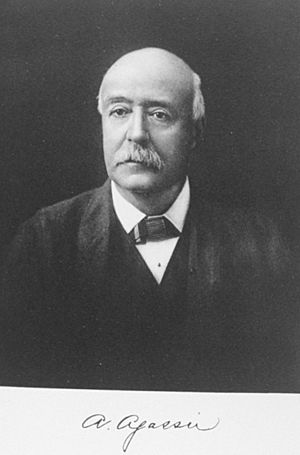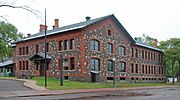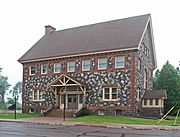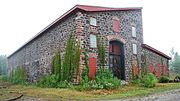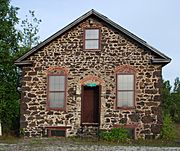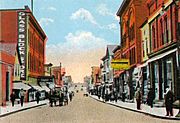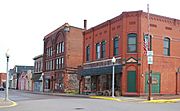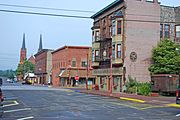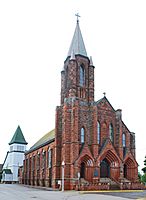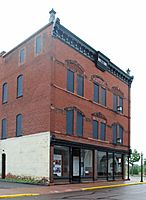Calumet Historic District facts for kids
|
Calumet Historic District
|
|
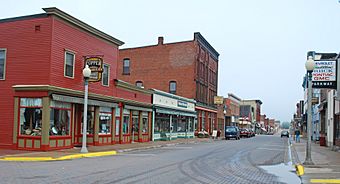
Streetscape on west side of 5th street, north of Scott
|
|
| Location | Area W of MI 26 S of Calumet Lake to Osceola, Calumet, Michigan |
|---|---|
| Area | 385 acres (156 ha) |
| Architect | Calumet & Hecla Mining Co. |
| NRHP reference No. | 89001097 |
Quick facts for kids Significant dates |
|
| Added to NRHP | March 28, 1989 |
| Designated NHLD | March 28, 1989 |
The Calumet Historic District is a special place in Calumet, Michigan. It's recognized as a National Historic Landmark, which means it's super important to the history of the United States. This district was given this title in 1989. It shows how important the community was for copper mining in the region.
Contents
What is the Calumet Historic District?
This historic district covers most of the village of Calumet. It also includes the areas around it where people lived and where the mines were. The district stretches from the Osceola Township line in the south. It goes to Pine, Elm, and Church Streets in the north. On the west, it includes Osceola, Sixth, and Seventh Streets. To the east, it reaches the back of the lots on Calumet Street.
The district also covers buildings on Waterworks Street. These are north of Pine Street, all the way to Calumet Lake. Some buildings near Oak Street, west of Seventh Street to Eleventh Street, are also part of it.
The Calumet Historic District is very similar to the Calumet Unit of the Keweenaw National Historical Park. It includes two other important historic areas. These are the Calumet Downtown Historic District and the Calumet and Hecla Industrial District. Both of these are also listed on the National Register of Historic Places.
History of Calumet's Copper Mining
In 1864, a man named Edwin J. Hulbert found a lot of copper here. This special copper rock was called the "Calumet Conglomerate." Hulbert quickly found people to invest money. He bought the land and started the Hulbert Mining Company.
His company soon had two smaller companies. These were the Calumet Mining Company (started in 1865) and the Hecla Mining Company (started in 1866). Hulbert began digging for copper. But he wasn't very experienced. This meant they didn't find much copper. His investors were not happy.
In 1867, the investors replaced Hulbert. They brought in Alexander Agassiz to run things. Under Agassiz, the Calumet and Hecla mines grew very fast. By 1870, they were digging up more than half of all the copper in the United States!
In 1871, the Calumet and Hecla Mining Companies joined together. They also added the Scott and Portland Mining Companies. This created the big Calumet and Hecla Mining Company. Agassiz became the president of this new, larger company. He stayed in that job until he passed away in 1910.
The village of Calumet started when Hulbert began mining in 1864. It was first called "Red Jacket." This name came from a Native American Chief of the Seneca tribe. In 1929, the village president, Joseph Asselin, changed the name to "Calumet." Calumet became an official town in 1867. Its success grew as the Calumet & Hecla Mining operations boomed.
The copper found in the Calumet Historic District was very important. It was probably the biggest development in US copper mining between 1867 and 1884. The Calumet and Hecla Mining Company, located here, produced over half of the nation's copper during those years. Even in 1882, after new copper was found in the western US, Calumet and Hecla still produced 63 percent of all US copper.
Later, other mines in the west grew bigger. Calumet and Hecla lost some of its top spot. But they bought up other companies. By the early 1900s, they were again competing with the biggest mines.
However, a big workers' strike in 1913-1914 hurt the company. Then, the Great Depression hit. The price of copper also dropped. These problems forced the company to stop mining in the 1930s. The company tried to get copper from other mines. They also tried to get copper from old mining waste. But they never made as much money as they did in the boom years. The Calumet & Hecla Company finally closed for good in 1968.
Why is Calumet Important?
The Calumet Historic District is important for many reasons. It shows major parts of Michigan's copper industry. These include mining technology, how immigrants settled, how companies supported towns, and how workers organized. Many mining companies worked in the Keweenaw Peninsula in the late 1800s. But the Calumet and Hecla Mining Company lasted the longest. It produced the most copper and had the most influence. It also used many new technologies.
The company was one of the first to use steam-powered machines. By the late 1890s, they had over fifty steam engines at their mine. They had more engines at their mills and smelters. In 1899, an official report said Calumet and Hecla produced "as much power as is now being generated by the great electric plant at Niagara Falls." Their surface plant was the biggest and most efficient in the country. It was built to last until all the copper was gone.
The Calumet and Hecla Mining Company also showed a special way of caring for its workers. They preferred to hire men with families. They thought these workers would be more stable. Most of their employees were immigrants. These workers were often willing to work for lower pay.
The company built good, low-cost houses for employees in Calumet. They also provided services for free. These included garbage collection, repairs, a fire department, and water. Calumet and Hecla also built a library and a school for their employees. They even built a hospital, a swimming pool, and other helpful places.
The company also gave money to build many churches. Many of these churches served the different groups of immigrants. Early miners came from Cornwall, Ireland, Germany, and France. Later, workers came from Italy, Poland, Slovenia, Croatia, and Scandinavia (especially Finland).
Buildings in Calumet
Industrial Calumet
The copper rock mined by Calumet & Hecla was in a narrow strip. It was only about one and a half miles long. This strip is roughly where Mine Street is today. Calumet & Hecla dug fifteen shafts along this copper strip. The buildings over these shafts are gone now. But many other mine-related buildings are still standing.
Many of these buildings are almost exactly as they were built. They are in good to excellent condition. Also, no new buildings have been put up in this area.
Important buildings built by the Calumet & Hecla Mining Company or its leaders still stand. These include the company office building, the town library, and Alexander Agassiz's home. Other buildings are the Miscowaubik club, the bathhouse, and the Calumet Village School.
Industrial buildings still here include a machine shop and a train engine house. There's also a paint house, a blacksmith's shop, and a pattern shop. Two warehouses, a firehouse, and a steam boiler house are also present. Even though the train tracks are gone, you can still see where they were.
These industrial buildings were built in a simple, practical style. They are mostly made of sandstone or red brick. Their foundations are made of grey mine rock.
| Industrial Calumet
|
|---|
Commercial Calumet
The main shopping area of Calumet is northwest of the Calumet & Hecla mine. You get to this area from the mine by Red Jacket Road. This road becomes Fifth Street in the village. Fifth and Sixth Streets are the main commercial area of Calumet.
The buildings here show how rich Calumet was during the copper boom. Business buildings made of sandstone and brick were built. These buildings are mostly rectangular. They have fancy metal cornices (decorative tops). They also have terra cotta decorations and cast iron details.
Some buildings have been lost over time. But the commercial part of Calumet still looks much like it did historically. The streets look unified, and the views are well-preserved. Because the economy has been slow, not many changes have been made to the old buildings.
| Downtown Calumet
|
|---|
Religious and Social Calumet
The Calumet and Hecla Mining Company encouraged social and religious groups. They wanted them to start chapters in the Calumet area. The company gave land to build many churches and halls. This included at least eight churches. There was also a Union Building for clubs and meeting places for different ethnic groups. The most famous of these was the Italian Hall (now gone). This was the site of the tragic Italian Hall disaster in 1913.
Along Red Jacket Road, between the commercial area and the mine, are many churches. The Union Building is also there. The most well-known church in this group is Ste. Anne's in New Town. It is now the Keweenaw Heritage Center at St. Anne's. Ste Anne's was designed in 1900. It is one of the most beautiful churches in the area. It was originally a French Canadian Roman Catholic church. The land for it was leased from the Calumet & Hecla Company.
Another important church, still used for services, is St. Paul's. It is on the corner of Eighth and Oak.
The Union Building is on Red Jacket Road near Ste. Anne's. It was built in 1889 on land given by the Calumet & Hecla Mining Company. The building first held the Masons and Odd Fellows groups. Over the years, more than twenty helpful organizations used it. The building of the Union Building shows how the Calumet & Hecla Mining Company supported the community. They carefully gave land to groups that would help shape the local culture and the lives of their workers. In 2011, the Union Building reopened as the Calumet Visitor Center for Keweenaw National Historical Park.
Agassiz Park is a wedge-shaped area east of downtown. It borders the mine property. It was originally an open common area, like parks in Boston. Some open space is still there. But a large part of the park was used to build affordable housing.
| Religious and Social Calumet
|
|---|
Residential Calumet
The residential areas of Calumet are around the main business district. They are mostly to the west and north. Many of these homes were built by the Calumet & Hecla Company. This was during the copper boom years from 1870 to 1910. Most were single-family homes or duplexes (two-family homes).
Many of these company homes are two-and-a-half-story wooden houses. They have clapboard or shingle siding. They sit on foundations made of mine rock. They also have gabled roofs (pointed roofs). Most of these homes look much like they did when they were first built. Some have had new siding added or front porches changed.
Houses of the richer merchants also exist in Calumet. These are in styles like Queen Anne and other Victorian styles. These houses are mostly in excellent condition.




